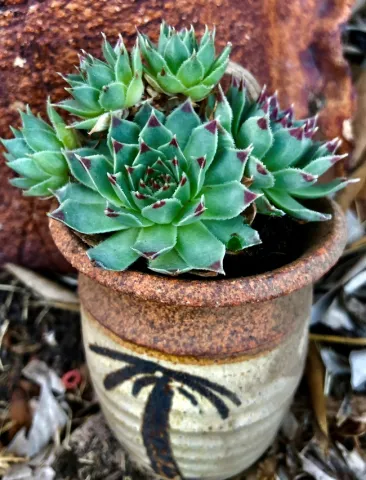
Hens And Chicks
By Ardis Neilsen UCCE Master Gardener
Common Name: hen-and-chicks or houseleeks Scientific Name: Sempervivum calcareum Planting Area: USDA 5-10 Size:width - 5 to 10 inches, height - 4 to 6 inches Growing Season: perennial Exposure: full sun, partial shade in hotter climates Pruning Needs: prune to control size and propagate |
|
Water Needs: drought tolerant, water deeply when dry
Sempervivum calcareum succulent – easy to grow
Sempervivum calcareums are best described as survivors. This reputation reflects their ability to endure freezing weather while their leaves remain green. In addition, it can survive with minimal watering and is a prolific propagator, producing multiple offsets (babies). It's botanical name “semper” and “vivum” translates to always living.
This evergreen, perennial succulent, commonly called hen and chicks or houseleeks, features symmetrical rosettes and varying leaf colors. Sempervivum's narrow, gray-green leaves form compact rosettes with magenta-spiked tips. A Sempervivum is generally disease and pest resistant, making it extremely easy to grow outdoors or indoors.
Native to the mountains of southern Europe, the ancient Romans used Sempervivums to decorate their graves, believing in the plant's ability to endure, suggesting immortality. In Europe, Sempervivums were grown on sod and gravel rooftops to prevent fire and lightning strikes due to their moisture content. That is how the common name “houseleeks” originated. (Succulent houseleeks are not related to leek vegetable plants.)
Sempervivum calcareum grows best in full sun and well-drained, sandy loam soil, or cactus potting mix. If summer temperatures regularly exceed 80 degrees, some afternoon shade is recommended.Liquid fertilizer should be used sparingly for potted plants.
Sempervivums are propagated by offsets and seeds. Baby (chicks) rosettes, grow in a circle around the large, mother (hen) rosette. The baby rosettes are attached to a stolon. The stolon easily breaks which allow the offsets (chicks) to roll away from the mother (hen) rosette or be transplanted.
During summer, star-shaped flowers grow from the mother rosette's single stem. The flowers produce seeds which can be used for propagation.
After the mother rosette flowers, it dies. Remove the dead rosette and flower, so the petite chicks can grow in its mother's place.
Sempervivums thrive in rock, vertical wall, and dish gardens. They have shallow roots, so deep pots are not required. Show off Sempervivum's best features - beautiful, intricate rosette patterns and contrasting leaf color – by growing them in decorative pots.
The UC Master Gardener Program will be participating in the 46th Annual Downtown Holiday Parade in SLO on December 2. Look for MG volunteers who will be handing out seed packets and marching alongside the Gardening Rocks float.
How to find us:
You can also view workshops on Instagram live at slo mg or visit our You Tube channel at “San Luis Obispo County UC Master Gardeners.”
Visit our website at ucanr.edu/sites/mgslo/ or email questions to anrmgslo@ucanr.edu.
Our physical offices are now open!!!!!
Covid may still affect staffing levels, so it is best to call before heading to your local Helpline office:
San Luis Obispo: 805-781-5939 (Monday and Thursday 1:00 to 5:00)
Arroyo Grande: 805-473-7190 (10:00 to 12:00)
Templeton: 805-434-4105 (Wednesday 9:00 to 12:00)

